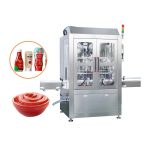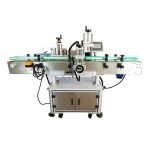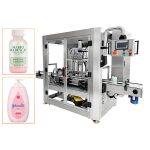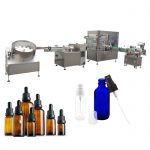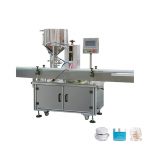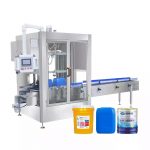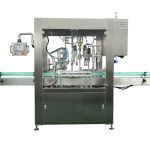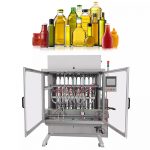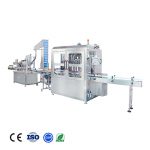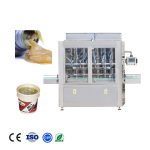What is peanut butter filling machine?
A peanut butter filling machine is a machine that is used to fill containers or packages with peanut butter. These machines are commonly used in food processing and packaging operations to efficiently and accurately dispense peanut butter into containers or packages. There are different types of peanut butter filling machines available, including liquid filling machines, volumetric filling machines, and weight-based filling machines. These machines can be used to fill a variety of containers, including jars, bottles, tubs, and bags. Peanut butter filling machines are designed to handle a range of viscosities and can be adjusted to dispense specific amounts of peanut butter. They are typically easy to operate and maintain and can be used to fill large volumes of peanut butter quickly and accurately.
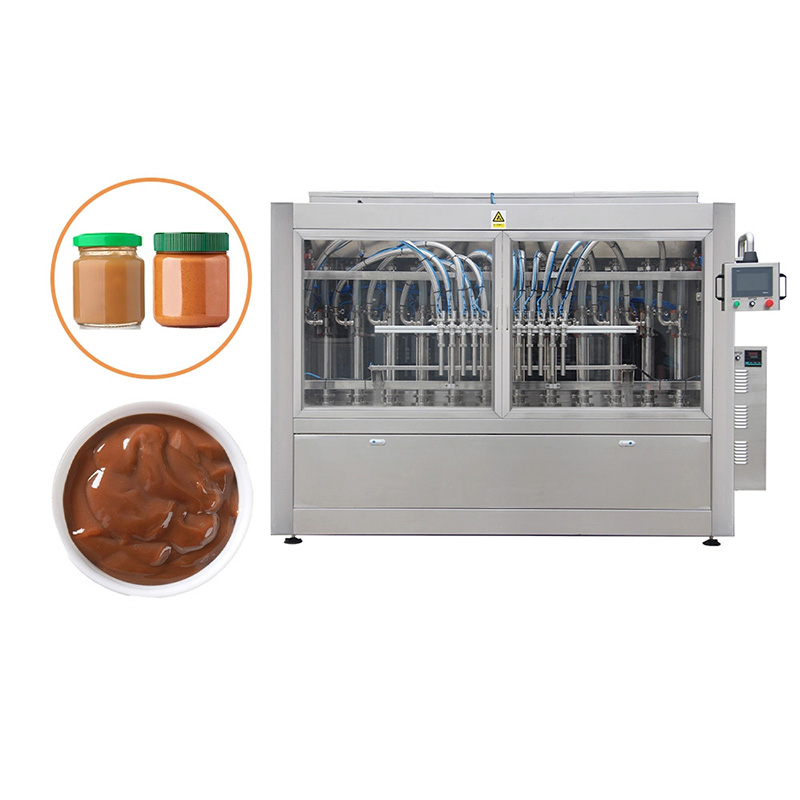
What is peanut butter?
Peanut butter is a type of food spread or condiment made from ground, dry-roasted peanuts. It is typically smooth in texture and has a nutty, rich flavor. Peanut butter is often spread on bread, toast, or crackers as a snack, or used as an ingredient in cooking and baking recipes.
Peanut butter is made by grinding peanuts into a paste using a food processor or blender. The peanuts are first roasted to bring out their flavor and then ground until they form a smooth, spreadable paste. Peanut butter can be made with just peanuts, or it can include other ingredients such as salt, sugar, and oil to improve its texture and flavor.
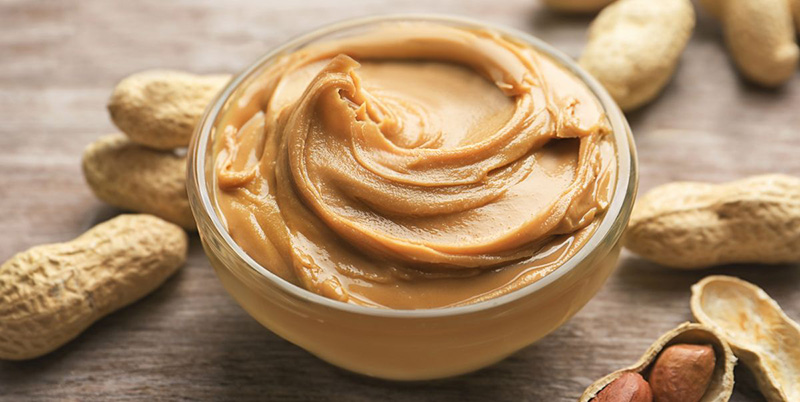
There are several different types of peanut butter available, including smooth and crunchy, as well as natural and processed varieties. Smooth peanut butter has a uniform, creamy texture, while crunchy peanut butter has bits of peanuts mixed in for added texture. Natural peanut butter is made with just peanuts and may include a small amount of salt, while processed peanut butter may contain additional ingredients such as sugar, hydrogenated vegetable oils, and artificial flavorings.
What are the common packaging peanut butter containers?
There are several different types of containers that are commonly used to package peanut butter, including:
- Jars: Peanut butter is often sold in glass or plastic jars with a screw-on lid. These jars are typically available in a range of sizes, from small individual servings to large, family-sized containers.
- Tubs: Peanut butter is also often packaged in plastic tubs with a flip-top lid. These containers are generally more convenient for scooping and spreading the peanut butter and are often used for large, bulk sizes.
- Squeeze bottles: Peanut butter is sometimes sold in squeeze bottles, which make it easy to dispense the peanut butter in a controlled manner. These bottles are often used for individual servings of peanut butter.
- Bags: Peanut butter is sometimes packaged in bags, which are typically made of plastic or foil. These bags are generally used for bulk sizes of peanut butter and are often used in food service settings.
What are the types of peanut butter filling machine?
There are several different types of peanut butter filling machines available, including:
- Liquid filling machines: These machines are designed to fill containers with liquids, including peanut butter. They use a variety of filling techniques, such as gravity filling, pressure filling, or pump filling, to dispense the peanut butter into the containers.
- Volumetric filling machines: These machines use a set volume to dispense the peanut butter into containers. They are often used for filling containers with precise amounts of peanut butter.
- Weight-based filling machines: These machines use a scale to weigh the peanut butter as it is being dispensed into containers. They are often used for filling containers with precise amounts of peanut butter.
- Auger filling machines: These machines use a screw-like device called an auger to dispense the peanut butter into containers. They are often used for filling containers with precise amounts of peanut butter and are well-suited for handling thicker, more viscous materials like peanut butter.
- Piston filling machines: These machines use a piston to dispense the peanut butter into containers. They are often used for filling containers with precise amounts of peanut butter and are well-suited for handling thicker, more viscous materials like peanut butter.
How to choose peanut butter filling machine?
There are several factors to consider when choosing a peanut butter filling machine, including:
- Production capacity: Consider the volume of peanut butter that you need to produce and choose a machine that can handle your production needs.
- Container size and type: Make sure the machine can accommodate the size and type of container that you will be using to package your peanut butter.
- Filling accuracy: Consider the level of accuracy that you need in your filling process. If you need precise amounts of peanut butter, choose a machine that is designed for accurate filling.
- Speed: Consider the speed at which you need to fill your containers. If you have a high volume of production, you may need a faster filling machine.
- Ease of use: Choose a machine that is easy to operate and maintain. This will help ensure that your filling process runs smoothly and efficiently.
- Cost: Consider your budget and choose a machine that fits within your price range.
- Brand reputation: Research different brands and choose a reputable brand with a good track record of producing high-quality filling machines.
How does the peanut butter filling machine work?
The specific way that a peanut butter filling machine works will depend on the type of machine that you are using. However, in general, peanut butter filling machines operate by using a filling mechanism to dispense the peanut butter into containers.
Here is a general overview of how a liquid filling machine might work:
- The peanut butter is placed in a hopper or reservoir on the filling machine.
- The machine is turned on and the peanut butter is dispensed through a filling nozzle or tube into the container.
- The filling nozzle or tube is usually equipped with a valve or other control mechanism to regulate the flow of peanut butter and ensure that the correct amount is dispensed into the container.
- The container is usually held in place by a filling head or fixture, which helps to keep the container steady during the filling process.
- Once the correct amount of peanut butter has been dispensed into the container, the filling process is complete and the container is moved to the next step in the packaging process, such as capping or labeling.
Other types of peanut butter filling machines, such as volumetric or weight-based filling machines, work in a similar way, but use different methods to dispense the peanut butter into the containers.
What are the components of peanut butter filling machine?
The specific components of a peanut butter filling machine will depend on the type of machine that you are using. However, in general, peanut butter filling machines may include the following components:
- Hopper or reservoir: This is where the peanut butter is stored and from which it is dispensed into the containers.
- Filling nozzle or tube: This is the part of the machine that dispenses the peanut butter into the container. It is usually equipped with a valve or other control mechanism to regulate the flow of peanut butter.
- Filling head or fixture: This is a device that holds the container in place during the filling process. It helps to keep the container steady and may include a mechanism to seal the container once the filling process is complete.
- Control panel: This is the part of the machine that allows the operator to control the filling process. It may include buttons, dials, or other controls for setting the filling speed and volume.
- Conveyor belt: Some peanut butter filling machines have a conveyor belt that moves the containers through the filling process. The conveyor belt may be equipped with sensors or other devices to ensure that the containers are properly aligned for filling.
- Pneumatic or hydraulic system: Some peanut butter filling machines use a pneumatic or hydraulic system to power the filling mechanism. This system may include pumps, cylinders, or other components to provide the necessary force for filling the containers.
- Electrical components: All peanut butter filling machines will have electrical components, such as motors and control panels, to power the machine and operate the filling mechanism.
What are the advantages of peanut butter filling machine?
There are several advantages to using a peanut butter filling machine in your food processing or packaging operation, including:
- Increased efficiency: Peanut butter filling machines are designed to fill containers quickly and accurately, which can help increase the overall efficiency of your operation.
- Improved accuracy: These machines are designed to dispense precise amounts of peanut butter, which helps to ensure that you are filling your containers with the correct amount of product.
- Reduced waste: By using a filling machine, you can minimize the amount of peanut butter that is wasted during the filling process. This can help reduce costs and increase profitability.
- Consistency: Peanut butter filling machines can help ensure that your containers are filled with a consistent amount of peanut butter, which can help improve the quality of your product.
- Reduced labor costs: Peanut butter filling machines can help reduce the amount of labor required to fill your containers, which can help save on labor costs.
- Increased safety: Peanut butter filling machines can help reduce the risk of accidents or injuries that can occur when filling containers manually.
- Ease of use: These machines are typically easy to operate and maintain, which makes them a convenient and user-friendly option for filling containers with peanut butter.
Customize your peanut butter filling line
If you are looking to customize your peanut butter filling line, there are several things that you can consider:
- Container size and type: Decide on the size and type of container that you will be using to package your peanut butter. This will help determine the type of filling machine that you will need.
- Filling speed: Consider the speed at which you need to fill your containers. This will help determine the size and capacity of the filling machine that you will need.
- Filling accuracy: Determine the level of accuracy that you need in your filling process. This will help determine the type of filling machine that you will need, as well as any additional features or accessories that may be required.
- Production capacity: Consider the volume of peanut butter that you need to produce and choose a filling machine that can handle your production needs.
- Ease of use: Look for a filling machine that is easy to operate and maintain, as this will help ensure that your filling process runs smoothly and efficiently.
- Brand reputation: Research different brands and choose a reputable brand with a good track record of producing high-quality filling machines.
- Cost: Consider your budget and choose a filling machine that fits within your price range.
By considering these factors, you can customize your peanut butter filling line to meet your specific needs and requirements.
Complete Peanut Butter Filling Line
A complete peanut butter filling line typically includes all of the equipment and machinery necessary to produce and package peanut butter. This may include a filling machine, as well as other equipment such as a conveyor belt, capping machine, labeling machine, and packaging machine.
Here is a general overview of the steps involved in a complete peanut butter filling line:
- Peanut butter production equipment: This may include equipment such as grinders, blenders, or mixers that are used to process the peanuts into peanut butter.
- Filling: The peanut butter is then dispensed into containers using a filling machine. The specific type of filling machine used will depend on the type of container and the level of accuracy required.
- Capping: The containers are then sealed with a lid or cap to keep the peanut butter fresh.
- Labeling: The containers are then labeled with information such as the product name, expiration date, and any other relevant information.
- Packaging: The filled and labeled containers are then packaged for distribution or sale. This may involve placing them in boxes or other packaging materials.
By following these steps, you can produce and package peanut butter efficiently and accurately.

